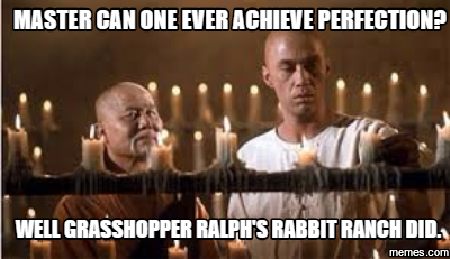Here at the Ralph's ranch we're always looking for new and improved foods that we can blend in to our feed that we give our herd. Recently, while reading a horticulturist magazine I came across some interesting, if not down right, bizarre facts.
Here are some interesting little factoids you may find of interest.
All watermelons have an even number of stripes on their outer rinds. Its true check it out.
Each ear of corn always has an even number of rows of kernels.
All stalks of wheat have an even number of grains.
Every orange has an even number of segments when you cut it in half.
Now here is the kicker - "every bunch of bananas" - has on its lowest row an even number of bananas. Its amazing as bananas grown the number of bananas on each row decreases "by one" on each succeeding row. So as you look at every bunch of bananas hanging in a tree there is an even row and an odd row with every bunch of bananas.
If you find information of this nature interesting let us know and we will post more for you. Likewise, if you do not find this kind of trivia of interest let us know as well and we will stop.
Thanks
Ralph
Welcome to Ralph's Ranch - the second largest commercial rabbit ranch in Wisconsin. Located in the pristine woods of northern WI; we hand-raise "Gabe's Bohemian Style" rabbits which are sold exclusively to fine dining establishments along the East, Gulf and West Coasts. We also offer artic fur lined gloves, olympic grade boot liners, stylish alpine muffs and sensual fur lined foundation garments to heighten connubial winter contact.
History of Ralph's Rabbit Ranch

Saturday, December 21, 2019
Wednesday, July 31, 2019
Surprisingly one of these three is lapped up more everyday by Americans than the other two combined. Plus, its consumption soars through the roof during warm summer days. People put this one condiment on their burgers, fries, sandwiches, pastas, hot dogs, scrambled eggs, meatloaf as well as dozens of other foods and snacks.
For years there was a big controversy as to what this condiment should be called? Some referred to it as Ketchup while others called it Catsup. This article will provide some insights on what these two terms mean and how they actually came about. You might be surprised at what you learn – so read on.
First off, there is no technical or culinary difference between Catsup and Ketchup both terms refer to a tomato based condiment? The words 'Ketchup' and ‘Catsup’ both stem from the Asian word ‘Kecap’ from ancient China. The Chinese word - 'kecap' - refers to a sauce generally put on fish.
British sailors who harbored in Chinese ports during the late 17th were introduced to Kecap and fell in love with it. Many brought it back to England and shared it with their families and friends who also enjoyed its unique flavor.
Ironically, the Kecap sauce the British sailors brought back it in the 17th century was not at all like the Ketchup or Catsup we have today. Kecap back then was a simple mixture of fish brine, herbs, vinegar and local Asian spices. Some local varities of were infused with walnuts or mushrooms or beans but never did Asians put tomatoes or tomato sauce in Kecap. The original Kecap would have had a taste similar to modern day Worcestershire sauce.
Over time European cooks and housewives began to experiment made alterations to both the taste and texture of Kecap. Once the sweet mild flavors of tomatoes and tomato sauce were added to Kecap its use and consumption exploded throughout Europe. Kecap was thus transformed into the condiment we know and love today way back in early 18th century.
Kecap officially entered the English vernacular in 1690 as 'Catsup'. As the condiment spread throughout northern, central and southern Europe the word Catsup somehow morphed into the word 'Ketchup'. The word Ketchup however did not officially enter the English language until 1711.
Surprisingly many Americans believe Henry John Heinz invented ketchup or that he was the first individual to put ketchup in a glass bottle – neither of those thoughts are true though. Henry Heinz, was the owner of the H. J. Heinz Company in Pittsburgh, Pennsylvania, and he was the first person to commercially market ‘Heinz Catsup’ nationwide in 1876. Because Heinz sold Catsup nationally he is credited for making Catsup a very popular condiment in the US.
After 10 years of selling “Heinz Tomato Catsup,” Heinz decided to change the name of his product to Heinz Ketchup. His reason for the change was to distinguish his product from all his other rival food manufacturers who were now selling Catsup. With the name change Heinz gained more sales and enjoyed even greater profits. Amazingly other food manufacturers still continued to sell their product as Catsup. Soon Ketchup and Catsup became synonymous and that’s where the confusing stems from!
Though Heinz Ketchup dominates the US condiment market there are still local and regional food manufactures who sell their product as ‘Catsup’. Hunts and Del Monte are two examples you might be familiar with.
Now get ready - here is some trivia you might find of interest. The world’s largest bottle of ‘Catsup’ is located in Brownsville, Illinois (southern Illinois – 47 miles east of Evansville, Indiana. The giant Catsup bottle was constructed as a water tower for a food processing plant back in 1949 by the Brooks Catsup company. It stands 170 feet tall and is made out of steel and painted to depict an actual Catsup bottle. In 2002 the Brooks Catsup bottle was placed on the Historical Register of Places because according to many Illinois natives its a part of American History and represents the true American spirit.
Subscribe to:
Posts (Atom)






